Abstract
Mating triggers behavioral and physiological changes in the Drosophila melanogaster female, including an elevation of egg laying. Seminal fluid molecules from the male accessory gland are responsible for initial behavioral changes, but persistence of these changes requires stored sperm. Using genetic analysis, we have identified a seminal fluid protein that is responsible for an initial elevation of egg laying. This molecule, Acp26Aa, has structural features of a prohormone and contains a region with amino acid similarity to the egg-laying hormone of Aplysia. Acp26Aa is transferred to the female during mating, where it undergoes processing. Here we report the generation and analysis of mutants, including a null, in Acp26Aa. Females mated to male flies that lack Acp26Aa lay fewer eggs than do mates of normal males. This effect is apparent only on the first day after mating. The null mutation has no other detectable physiological or behavioral effects on the male or the mated female.
Full text
PDF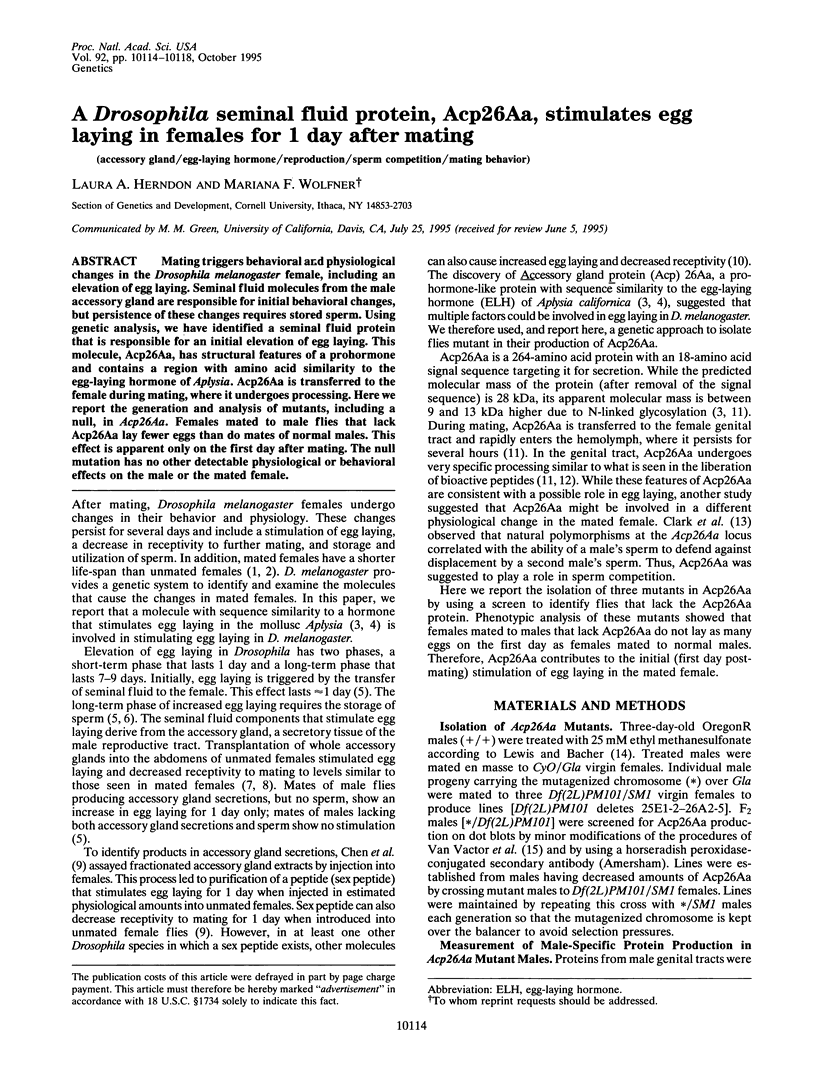
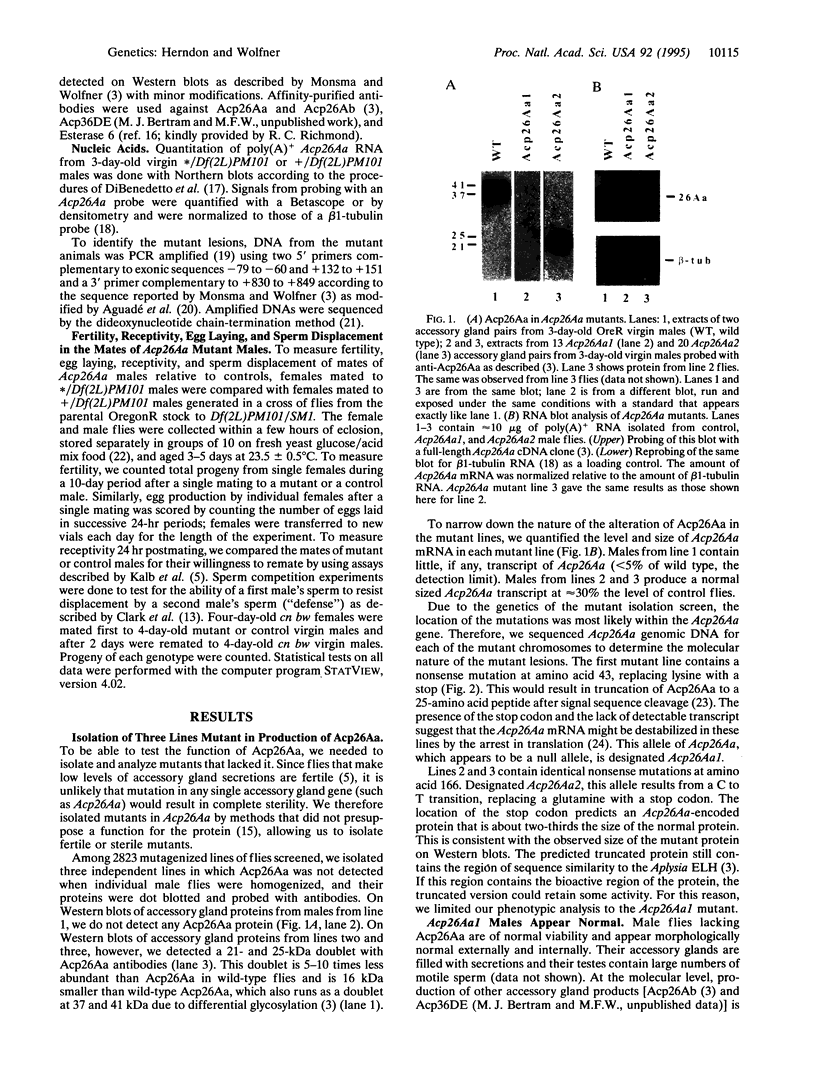
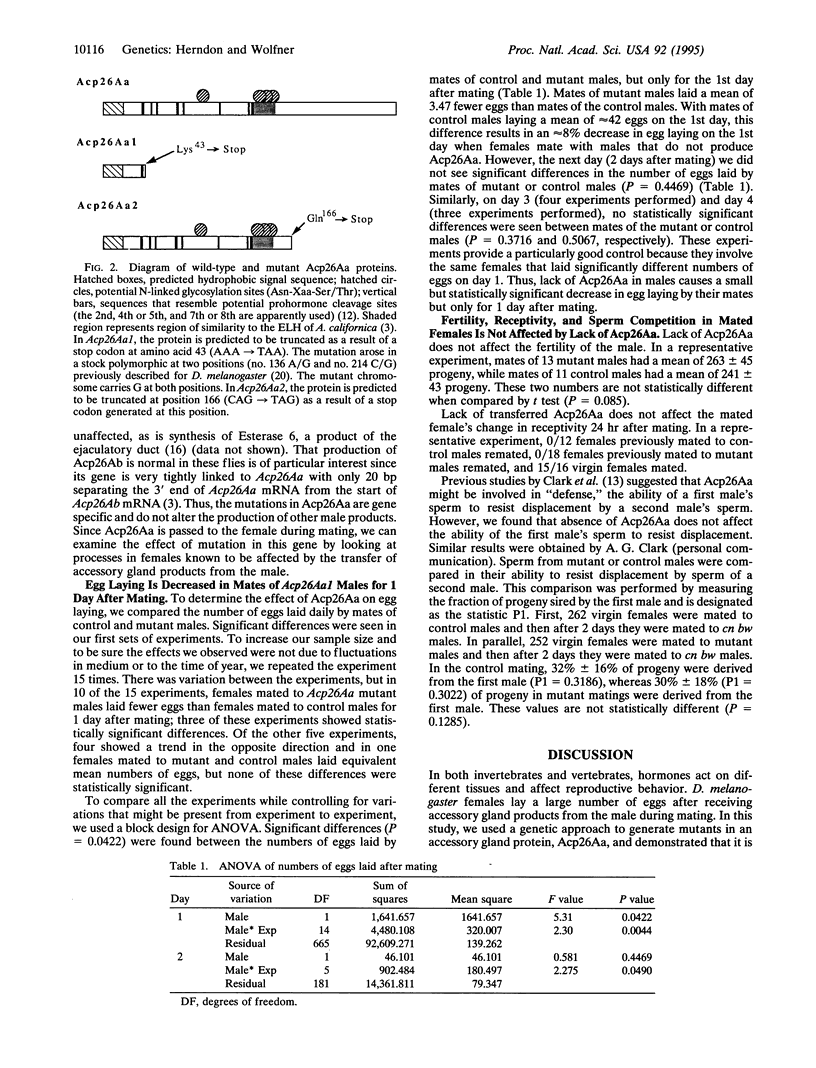
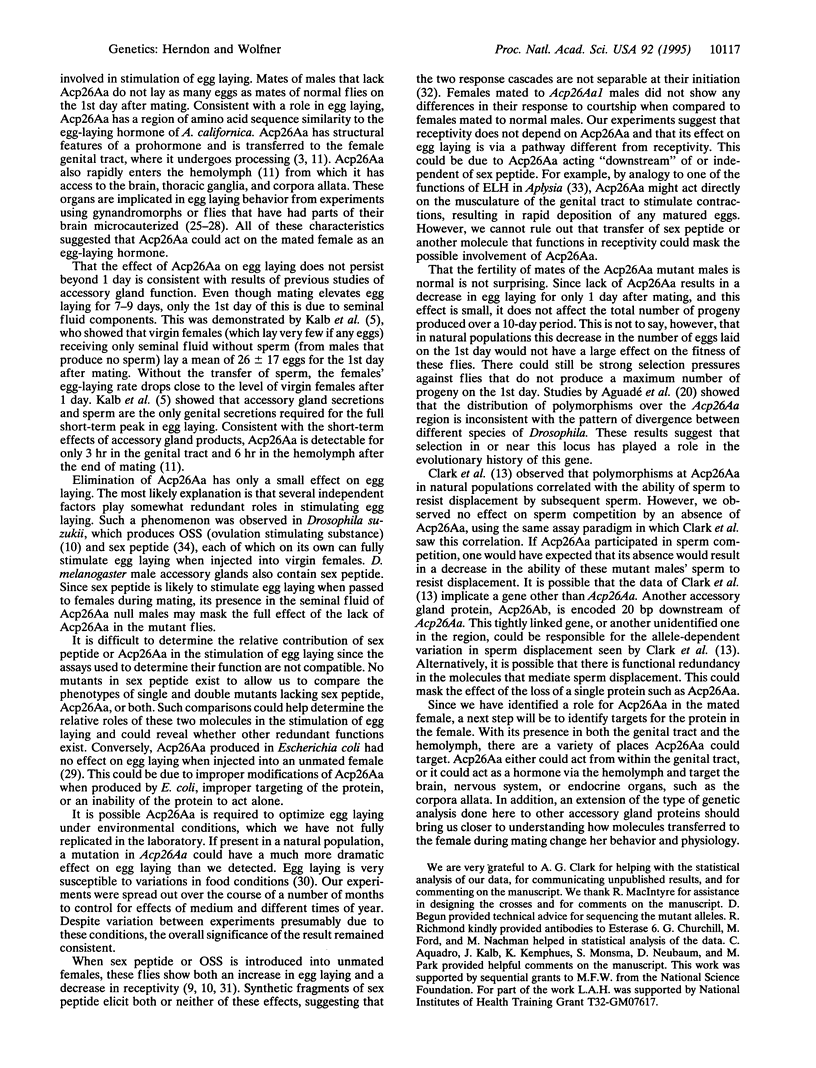
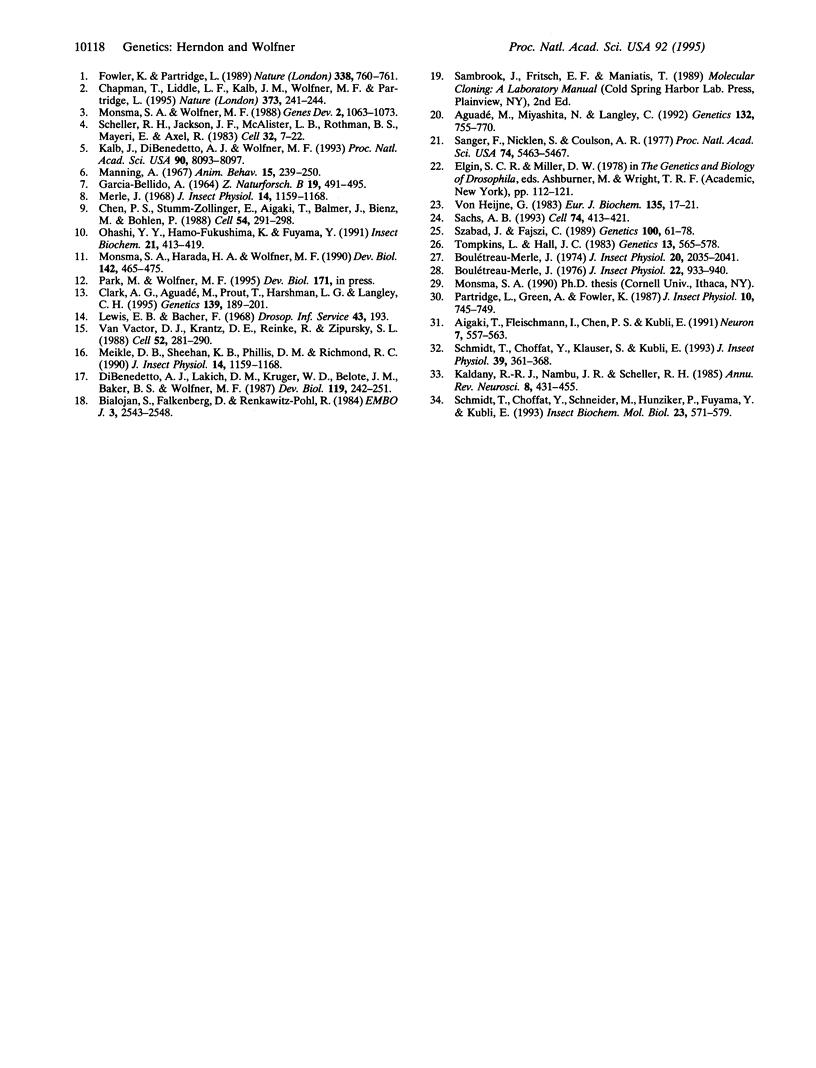
Images in this article
Selected References
These references are in PubMed. This may not be the complete list of references from this article.
- Aguadé M., Miyashita N., Langley C. H. Polymorphism and divergence in the Mst26A male accessory gland gene region in Drosophila. Genetics. 1992 Nov;132(3):755–770. doi: 10.1093/genetics/132.3.755. [DOI] [PMC free article] [PubMed] [Google Scholar]
- Aigaki T., Fleischmann I., Chen P. S., Kubli E. Ectopic expression of sex peptide alters reproductive behavior of female D. melanogaster. Neuron. 1991 Oct;7(4):557–563. doi: 10.1016/0896-6273(91)90368-a. [DOI] [PubMed] [Google Scholar]
- Bialojan S., Falkenburg D., Renkawitz-Pohl R. Characterization and developmental expression of beta tubulin genes in Drosophila melanogaster. EMBO J. 1984 Nov;3(11):2543–2548. doi: 10.1002/j.1460-2075.1984.tb02170.x. [DOI] [PMC free article] [PubMed] [Google Scholar]
- Boulétreau-Merle J. Destruction de la pars intercerebralis chez Drosophila melanogaster: effet sur la fécondité et sur sa stimulation par l'accouplement. J Insect Physiol. 1976;22(7):933–940. doi: 10.1016/0022-1910(76)90074-3. [DOI] [PubMed] [Google Scholar]
- Boulétreau-Merle J. Stimulation de l'ovogenèse par la copulation chez les femelles de Drosophila melanogaster privées de leur complexe endocrine rétrocérébral. J Insect Physiol. 1974 Oct;20(10):2035–2041. doi: 10.1016/0022-1910(74)90110-3. [DOI] [PubMed] [Google Scholar]
- Chapman T., Liddle L. F., Kalb J. M., Wolfner M. F., Partridge L. Cost of mating in Drosophila melanogaster females is mediated by male accessory gland products. Nature. 1995 Jan 19;373(6511):241–244. doi: 10.1038/373241a0. [DOI] [PubMed] [Google Scholar]
- Chen P. S., Stumm-Zollinger E., Aigaki T., Balmer J., Bienz M., Böhlen P. A male accessory gland peptide that regulates reproductive behavior of female D. melanogaster. Cell. 1988 Jul 29;54(3):291–298. doi: 10.1016/0092-8674(88)90192-4. [DOI] [PubMed] [Google Scholar]
- Clark A. G., Aguadé M., Prout T., Harshman L. G., Langley C. H. Variation in sperm displacement and its association with accessory gland protein loci in Drosophila melanogaster. Genetics. 1995 Jan;139(1):189–201. doi: 10.1093/genetics/139.1.189. [DOI] [PMC free article] [PubMed] [Google Scholar]
- DiBenedetto A. J., Lakich D. M., Kruger W. D., Belote J. M., Baker B. S., Wolfner M. F. Sequences expressed sex-specifically in Drosophila melanogaster adults. Dev Biol. 1987 Jan;119(1):242–251. doi: 10.1016/0012-1606(87)90225-9. [DOI] [PubMed] [Google Scholar]
- GARCIA-BELLIDO A. DAS SEKRET DER PARAGONIEN ALS STIMULUS DER FEKUNDITAET BEI WEIBCHEN VON DROSOPHILA MELANOGASTER. Z Naturforsch B. 1964 Jun;19:491–495. [PubMed] [Google Scholar]
- Kalb J. M., DiBenedetto A. J., Wolfner M. F. Probing the function of Drosophila melanogaster accessory glands by directed cell ablation. Proc Natl Acad Sci U S A. 1993 Sep 1;90(17):8093–8097. doi: 10.1073/pnas.90.17.8093. [DOI] [PMC free article] [PubMed] [Google Scholar]
- Kaldany R. R., Nambu J. R., Scheller R. H. Neuropeptides in identified Aplysia neurons. Annu Rev Neurosci. 1985;8:431–455. doi: 10.1146/annurev.ne.08.030185.002243. [DOI] [PubMed] [Google Scholar]
- Manning A. The control of sexual receptivity in female Drosophila. Anim Behav. 1967 Apr-Jul;15(2):239–250. doi: 10.1016/0003-3472(67)90006-1. [DOI] [PubMed] [Google Scholar]
- Merle J. Fonctionnement ovarien et réceptivité sexuelle de Drosophila melanogaster après implantation de fragments de l'appareil génital mâle. J Insect Physiol. 1968 Aug;14(8):1159–1168. doi: 10.1016/0022-1910(68)90055-3. [DOI] [PubMed] [Google Scholar]
- Monsma S. A., Harada H. A., Wolfner M. F. Synthesis of two Drosophila male accessory gland proteins and their fate after transfer to the female during mating. Dev Biol. 1990 Dec;142(2):465–475. doi: 10.1016/0012-1606(90)90368-s. [DOI] [PubMed] [Google Scholar]
- Monsma S. A., Wolfner M. F. Structure and expression of a Drosophila male accessory gland gene whose product resembles a peptide pheromone precursor. Genes Dev. 1988 Sep;2(9):1063–1073. doi: 10.1101/gad.2.9.1063. [DOI] [PubMed] [Google Scholar]
- Sachs A. B. Messenger RNA degradation in eukaryotes. Cell. 1993 Aug 13;74(3):413–421. doi: 10.1016/0092-8674(93)80043-e. [DOI] [PubMed] [Google Scholar]
- Sanger F., Nicklen S., Coulson A. R. DNA sequencing with chain-terminating inhibitors. Proc Natl Acad Sci U S A. 1977 Dec;74(12):5463–5467. doi: 10.1073/pnas.74.12.5463. [DOI] [PMC free article] [PubMed] [Google Scholar]
- Scheller R. H., Jackson J. F., McAllister L. B., Rothman B. S., Mayeri E., Axel R. A single gene encodes multiple neuropeptides mediating a stereotyped behavior. Cell. 1983 Jan;32(1):7–22. doi: 10.1016/0092-8674(83)90492-0. [DOI] [PubMed] [Google Scholar]
- Schmidt T., Choffat Y., Schneider M., Hunziker P., Fuyama Y., Kubli E. Drosophila suzukii contains a peptide homologous to the Drosophila melanogaster sex-peptide and functional in both species. Insect Biochem Mol Biol. 1993 Jul;23(5):571–579. doi: 10.1016/0965-1748(93)90030-v. [DOI] [PubMed] [Google Scholar]
- Szabad J., Fajszi C. Control of female reproduction in Drosophila: genetic dissection using gynandromorphs. Genetics. 1982 Jan;100(1):61–78. doi: 10.1093/genetics/100.1.61. [DOI] [PMC free article] [PubMed] [Google Scholar]
- Tompkins L., Siegel R. W., Gailey D. A., Hall J. C. Conditioned courtship in Drosophila and its mediation by association of chemical cues. Behav Genet. 1983 Nov;13(6):565–578. doi: 10.1007/BF01076402. [DOI] [PubMed] [Google Scholar]
- Van Vactor D., Jr, Krantz D. E., Reinke R., Zipursky S. L. Analysis of mutants in chaoptin, a photoreceptor cell-specific glycoprotein in Drosophila, reveals its role in cellular morphogenesis. Cell. 1988 Jan 29;52(2):281–290. doi: 10.1016/0092-8674(88)90517-x. [DOI] [PubMed] [Google Scholar]
- von Heijne G. Patterns of amino acids near signal-sequence cleavage sites. Eur J Biochem. 1983 Jun 1;133(1):17–21. doi: 10.1111/j.1432-1033.1983.tb07424.x. [DOI] [PubMed] [Google Scholar]



